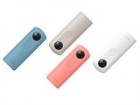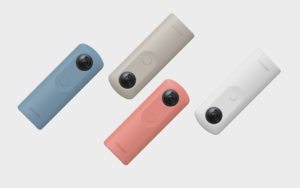
GR III dominates the Ricoh booth Ricoh formally launched the GR III earlier this week, so it's no surprise that its presence dominates the company's stand at CP+. The units on display are running firmware 1.
0 and we're told we'll be able to get our hands on one in the next few days to go shooting with.
Familiar controls
Many of the camera's features will immediately be familiar to users of previous GR models. The ADJ lever controls exposure compensation or brings up a customizable menu of core camera functions. Several of the camera's buttons can also be re-assigned, including a dedicated Fn button, the left and right presses of the four-way controller and the movie/Wi-Fi button on the side (which can control a second function in response to a long press). And, of course, there's the 'Full Press Snap' focus option that leaves the camera pre-focused to your chosen distance, to maximize responsiveness. The improved speed of being able to position the AF point that the touchscreen brings may not wholly outweigh the loss of the rocker that's featured on the back of GR cameras up until now for experienced users.
New lens, new autofocus
The GR III adds phase detection autofocus but, interestingly, still appears to use a unit focus design, where the entire lens is moved back and forth as the camera focuses. This helps maximize image quality, as the lenses maintain their relationships to one another, but slows down the process, since it means moving more mass. The addition of phase-detection autofocus helps with this, since it means the lens can be driven straight to the desired location, but the autofocus of these firmware v1. 0 cameras wasn't especially speedy.
Innovation and legacy
Ricoh was keen to show that, while the GR III is a relatively major update to the series, it understands that it needs to fit into a series that goes back over twenty years. It's an important reminder that, even relatively recently, the GR series attracted a dedicated audience even when they were built around relatively modest 1/1. 7" sensors. Anyone who enjoyed one of the GR Digital models is likely to be impressed with what the GR III offers. And we're looking forward to getting a closer look at the final JPEGs soon.
Ricoh Theta goes 1"
The Theta VR camera has been something of a success for Ricoh and it's been progressively iterating on the design for a number of years. Back at Photokina 2016 they told us one of the big challenges they faced was trying to cope with the heat generated by 4K capture without having to change the popular form-factor of the device. The Theta Z1 shows how far things have come since then. The Theta Z1 is not only capable of 4K video capture but does so from a pair of 1"-type sensors.
Ricoh Theta Z1 with DNG Raw
The Theta Z1 is a little taller and a little thicker than previous models but they're relatively minor changes, considering how much larger the sensors its using are. Bear in mind that the Theta's 360° capability is formed by having two of these chips mounted back-to-back, it's not surprising that the Z1 had to get a little (~6mm) thicker. Despite this slight extra separation, its lenses are able to give an overlapping view to form a 360° view. And, unlike previous versions, the Z1 can shoot DNG Raw stills.
. dpreview.com2019-3-1 15:00







